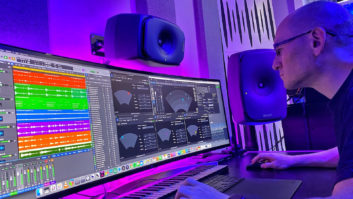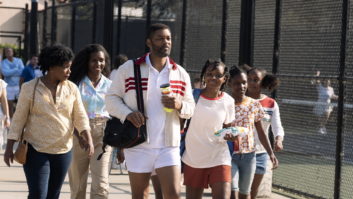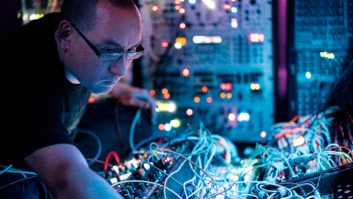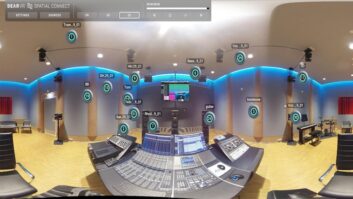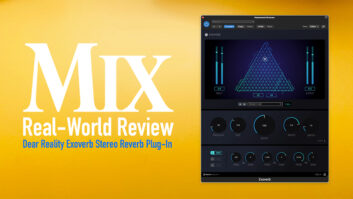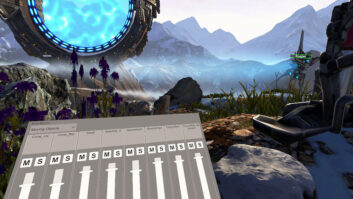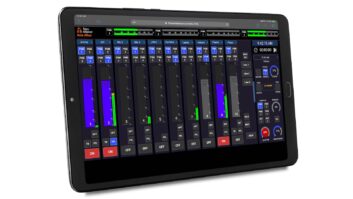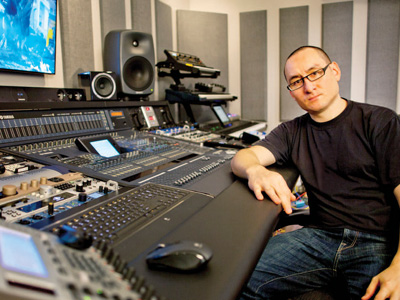
I’d like to tell you what Richard Devine is working on right now, but I’m sworn to secrecy.
The Atlanta-based producer and sound designer is well-known for remixing the likes of Aphex Twin, and designing sounds for hardware synths and music software such as Reason and Absynth. His work for corporate clients, however, often flies under the radar.
Devine is in demand by tech giants such as Apple, Sony and Microsoft, and he is increasingly called upon for top-secret projects developing sonic environments for everything from apps to automobiles.
His newest work is in the exploding field of sound design for virtual reality, which he delved into in 2015 when Google hired him to create the entire sonic realm of the company’s Daydream virtual reality platform, from designing navigation sounds to assuring consistency in virtual environments. “I basically flew out to Google’s headquarters in Mountain View and got a three-week crash course in virtual reality at their offices,” he says. “I just jumped right in from that point.”
One of Devine’s most significant projects at Google was creating or- ganic textures and sounds for the Google Earth VR app, a process that began with location recording using a Sennheiser AMBEO VR mic and Soundfield ST450 Ambisonic mic and an 8-channel Sound Devices recorder. “If you were in a forest or near a lake, you would hear sounds of water or birds and wind noise and crickets; depending on where you are in the world,” he says. “We have this library of sounds that I recorded in Ambisonics format; it plays in various locations, depending on where you are on the planet.”
Devine worked in Google’s Virtual Reality (VR) SDK; sound design involved adapting environments to match the time of day, conveying a natural sense of localization with effects, programming seamless loops, and creating an immersive sonic environment that never overwhelmed the user with too many natural sounds.
Maintaining subtlety sometimes meant replacing “busy” location recordings in the studio, ADR style. “I used an application environment called Pure Data,” Devine explains. “I created the crickets using synthesis and re-recorded them in quad, in my studio, in a perfectly soundproof, controlled environment.
“With the software, I was able to con- trol the rate of the crickets, and I could also randomize the playback for each one of the speakers so it would sound like a different cricket coming from each direction,” he says. “Everything was completely lean; we later took those sounds and imported them into the Unity 3D engine, and we used scripts that would randomize file playback, so you wouldn’t think it was just a loop.”
To create a sense of distance in, for example, sounds of birds in trees, Devine programmed Unity 3D scripts to evolve reflection patterns. “If you were hearing a cricket that was on the floor, you placed a ‘sound emitter’ on the floor, and then the closer you get, the less reverb it applies,” Devine explains. “There are scripts that detect the position of your head in the environment, so as you get closer to something, it pulls back the reverb and gets more detailed as you are turning your ear or are closer to the ground.”
It’s difficult to comprehend fully virtual reality’s potential to redefine our relationship with sound, but the implications are vast. For example, Devine worked on a Google project called Blind VR that enables sight-impaired users to navigate objects in a room through echolocation, via a controller’s haptic feedback. And he’s hinted at secret projects that involve developing new sensory languages of sorts for VR controller platforms.
“Just the way we play music in the future will be different,” Devine says. “When I was at Google, we were working on a music app where you could place instruments in a space and play them in a way you would never be able to play them normally, like set up a drum kit floating in the air and have 15 cymbals. You could set them vertically.
“You can do things that are physically impossible within the natural, normal environment. I think it’s going to open up a whole world of new creative art and music; it’s just really exciting.”
